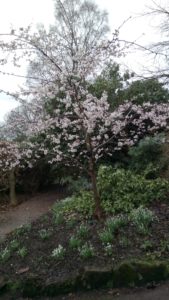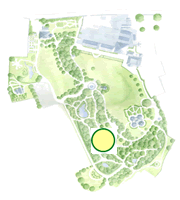Prunus hirtipes
Plant of the month: March
 |
 |
A member of the Rosaceae family, Prunus hirtipes can be found on Wilson Walk.
This small tree was discovered by E H Wilson in 1900 on the mountains of W Hubei and Sichuan at an altitude of 1500m. It was introduced into cultivation in 1907.
It is a tree that flowers reliably very early in the year, usually in February, and is smothered in baby pink flowers for many weeks. These flowers resemble small roses and are slightly fragrant – an extra bonus.
P. hirtipes has an elegant open shape and is quite small growing to about 12m. In the autumn it carries small red fruit.
This deciduous tree with alternate simple leaves that are elliptical in shape turn red in autumn. A simple leaf is one that is entire, not split into sections.
In Japan, the blooming of cherry trees is an event of great importance; weather reporters regularly give blossom forecasts. This event is known as hanami (flower viewing) and the cherry blossom is eagerly awaited each year, with hanami parties being organised as the blooms open. The practice started in the 8th century and hanami was the time to perform rituals to mark the start of the planting season.
Why don’t you come along and mark the start of the planting season surrounded by blossom?
Cultivation
Deciduous prunus should be grown in well drained but moisture retentive soil, in as much sun as possible to ensure good flowering and autumn colour.
Prune as necessary in late summer, ensuring a long period for the wounds to heal before winter sets in.
Prunus hirtipes should produce true from seed as long as it is not cross pollinated by another prunus close by.
Prunus can suffer from a variety of pests and diseases, but this is more likely if the tree is growing poorly. Ensure the tree is growing well by feeding regularly and ensuring good hygiene.

